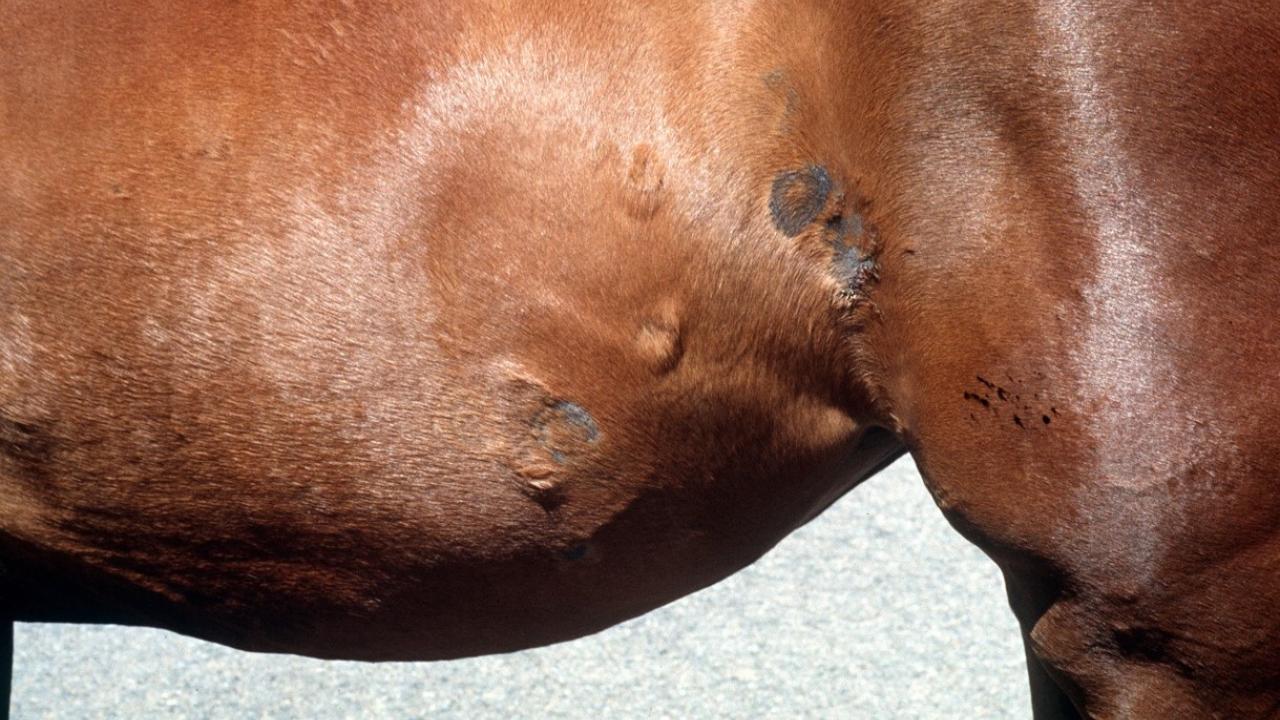
Ringworm in Horses (Dermatophytosis)
What is ringworm?
Takeaways
- Ringworm is a skin disease caused by a fungus (dermatophyte).
- Ringworm often results in a circular pattern of hair loss.
- Dermatophytes can be transmitted by direct contact between horses, or on tack and other equipment.
- To prevent ringworm, keep new horses separated for a few weeks after they arrive and monitor their health, and do not share tack and other equipment between horses.
Ringworm, or dermatophytosis, is one of the most common skin diseases that affects horses. Despite its name, ringworm is actually a fungus (primarily Trichophyton equinum and Trichophyton mentagrophytes in horses). These dermatophytes typically live on rodents and in the soil and are transmitted by direct contact between horses, or on tack, grooming equipment, clothing, and other fomites.
What are the clinical signs of ringworm?
The clinical signs of ringworm usually include an itchy, circular pattern of hair loss (the ‘ring’), sometimes accompanied by redness or a rash. In horses, ringworm commonly occurs on the girth and saddle areas and can spread to other parts of the body.
How is ringworm diagnosed?
Diagnosing ringworm involves taking a hair sample for a fungal culture in the laboratory. It is important to confirm the diagnosis as other conditions can mimic ringworm in appearance. Molecular PCR tests have been developed to identify DNA from specific dermatophyte species.
How is ringworm treated?
In some cases, ringworm resolves on its own without treatment, but it can take a month or more. Therefore, it is important to treat horses as soon as possible to limit their discomfort and avoid spreading the fungus to other animals and people.
Treatment may consist of antifungal shampoos, dips, or topical therapies. Treatments such as oral griseofulvin and terbinafine, or intravenous sodium iodide are also available, but potential unwanted side effects, such as liver damage, evidenced by elevated liver enzymes, and birth defects, should be taken into account. It is important to follow veterinary and product instructions to achieve the maximum effect.
Treatment also extends beyond the horse. Tack, blankets, grooming equipment, and other potentially contaminated surfaces should be disinfected to limit the spread of disease. If a known soil-borne fungal species is identified through laboratory culture, the ground and/or stall floor should be treated with bleach to try to eliminate the organism.
What is the prognosis for ringworm?
Topical treatments for ringworm in horses are often successful, and regrowth of hair is usually observed in one to four weeks. Untreated, cases of ringworm may resolve on their own in two to three months. However, the affected horse may be in discomfort, and delaying treatment risks spreading the disease to other horses, as well as people and other animals.
How can ringworm be prevented?
The incubation period of ringworm in horses can be up to 3 weeks, which means that other horses, as well as humans and other animals, can be exposed before clinical signs are visible. It is always advisable to keep new horses separated from the resident population for a few weeks and closely monitor them for signs of disease, including ringworm. Ensure that each horse has its own tack and equipment, and do not share between horses.
For more information
Dermatophyte culture - California Animal Health and Food Safety Laboratory (CAHFS)
PCR test for T. mentagrophytes - UC Davis PCR Laboratory
*This article may not be reproduced without the written consent of the UC Davis Center for Equine Health. Please email requests to cehadmin@ucdavis.edu.
